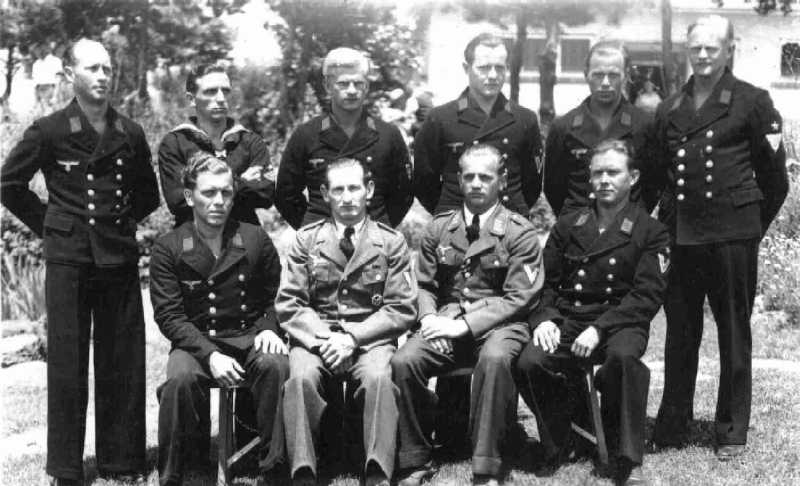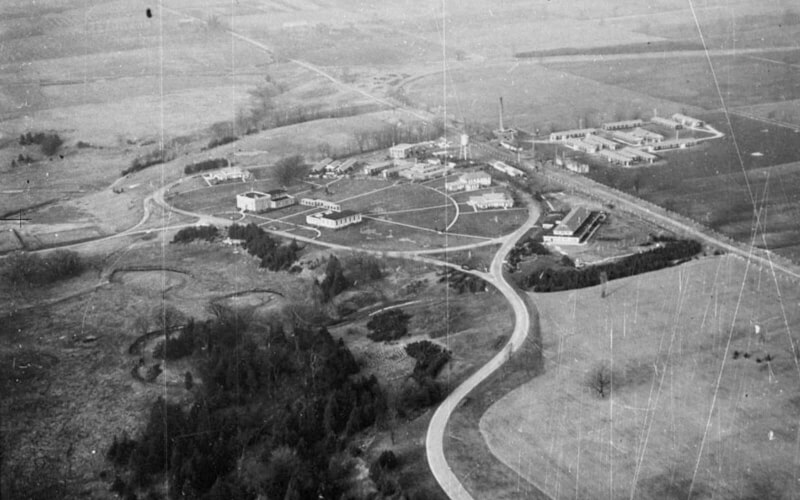
Bowmanville prisoners of war. [U-35.com]
The order was a recipe for disaster on what would be a disastrous day in Dieppe, France, on Aug. 19, 1942. There, some 6,100 Allied troops—4,963 Canadians among them—endured nine hours of hell as the German defenders cut them to ribbons. The Dieppe Raid incurred about 3,000 casualties, amounting to almost half the original assault force; of those, more than 900 Canadian dead littered the bloodied shingles and wrecked commune, while 1,946 were taken prisoner.
Searching the washed-up bodies and burnt-out vehicles, the victorious Germans found the orders. Hitler was outraged—and it was destined to get far worse.
In October, British commandos carried out another raid on the enemy-occupied Channel Island of Sark. Captured German soldiers were bound with rope and, when some of those prisoners attempted to escape, were killed.
Word of the incident again reached the Führer, who shortly thereafter ordered that 1,376 Allied PoWs, predominantly Canadians captured at Dieppe, be manacled. British Prime Minister Winston Churchill promptly reciprocated by demanding that German prisoners receive similar treatment. It was the beginning of a tit-for-tat escalation that would ultimately, if debatably, culminate in the only battle of the Second World War to take place on Canadian soil—depending on one’s definition of a “battle.”

Bowmanville prisoner of war camp. [ivebeenbit.ca]
It wasn’t long until the Veterans Guard had a full-blown revolt on its hands.
In Bowmanville, Ont., the 3,600-strong civilian population received a less-than-welcome boost when Camp 30, a German prisoner-of-war facility, was established in 1941. A former boys’ training school since encircled by a double-wire fence and guard towers, the site housed upward of 800 PoWs at times, mostly overseen by former Great War servicemen belonging to the Veterans Guard of Canada.
“It was the best prisoner-of-war camp in the world,” recalled one past inmate in later life, perhaps remembering numerous luxuries ranging from garden plots to an indoor pool (inherited from the previous on-site school). With access to games, activities, high-quality food and medical care, in addition to their pay, German occupants lived in relative comfort. Internees who gave their ehrenwort (word of honour) not to escape could even leave the camp to enjoy cross-country skiing.
Such borderline harmony came to a crashing halt when, on Oct. 10, 1942, the British government pressured its Canadian counterpart to shackle prisoners. Though initially reluctant to comply, the orders soon reached Camp 30.
It wasn’t long until the Veterans Guard had a full-blown revolt on its hands.
“There is ongoing controversy and confusion about whether the [October 1942 Bowmanville] incident was directly related to the Dieppe Raid or Sark Raid,” explained Canadian military historian David O’Keefe, author of the bestselling One Day in August: The Untold Story Behind Canada’s Tragedy at Dieppe. “However, it is clear that the orders to bind prisoners’ hands were given at Dieppe, and the general reaction has long been understood to stem from that event.”
Having refused the shackling demand, prisoners barricaded themselves in buildings, armed with rudimentary weapons—broom handles, hockey sticks, bottles, bricks—ready for the inevitable siege. Over the ensuing three-day tussle, the guards, bolstered by Canadian trainee soldiers, deftly subdued rioters in several buildings, yet there were also strongholds that posed far greater challenges.
One such bastion became the site of an especially bitter struggle when a water hose was fed into the structure and turned on. Those defending within were forced outside, soaked and demoralized, only to be confronted by a Canadian officer who was reportedly known and disliked for striking prisoners with his swagger stick.
A brawl broke out in which the lieutenant in question was captured by the Germans before they made a hasty retreat into a building. One prisoner was wounded and later hospitalized when a Canadian guard opened fire from a nearby tower.
“We were shattered when we looked from our windows and saw the Canadians marching in.”
By Oct. 12—Thanksgiving—it had become evident that the battered and bruised Canadians needed reinforcements to quell the revolt. One guard had suffered a fractured skull after a PoW used a jam jar as a missile. Enough was enough.
A new contingent of troops, fresh from training exercises, attempted a light-handed response that failed to impress. “We thought the Canadians would come in with machine guns, tear gas and grenades,” Kapitänleutnant Horst Elfe, commander of U-93, remarked. “So, we were shattered when we looked from our windows and saw the Canadians marching in with…just baseball bats over their shoulders.”
Asserting authority with rifles and bayonets proved more persuasive when the men changed tactics, even with orders not to use them under any circumstances. Thus, the so-called Battle of Bowmanville ended without any further shots fired. Both sides could be thankful that no one had died.
“Rather than using brutal force as the Germans might have—resorting to the likes of flamethrowers or machine guns—the Canadians treated [the Bowmanville revolt] more like a prison riot by employing policing methods,” said O’Keefe. “This showed a great deal of restraint and respect for the rule of law.”
But there was still the dreaded business of shackling prisoners, an order that no one wished to implement. Over the coming weeks, anecdotal accounts alluded to guards loosening restraints and pretending to drop keys behind closed doors.
Regardless, on Dec. 12, 1942, Churchill’s shackling order was revoked in what could almost be perceived as an early Christmas present. In doing so, Canadian Prime Minister Mackenzie King was himself freed from a political nightmare in which the country had been effectively forced to flout the Geneva Conventions.
Today, the remnants of Camp 30, though in a state of disrepair, constitute the last surviving Second World War-era prisoner-of-war facility in Canada. Conservation efforts continue, spearheaded by the not-for-profit Jury Lands Foundation. While its fate might still be undecided, its history remains unique—if perhaps bizarre.
Advertisement






















